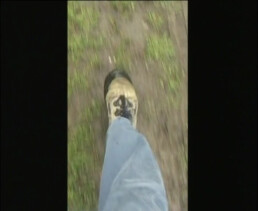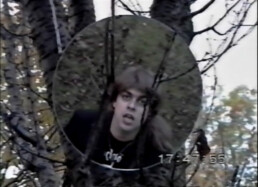FUSO INSULAR 2023 – 26 a 28 de Outubro
26 Outubro, 21h30
Igreja do Colégio – Ponta Delgada
LET’S DANCE!
Curadoria de Pascale Cassagnau
Quando as técnicas de gravação de imagem (o cinema, e mais tarde o vídeo) foram inventadas, artistas, bailarinos e coreógrafos apossaram-se dos territórios das imagens em movimento para colocar suas atuações (performances) em perspectiva, traçar hipóteses de pesquisa e abrir novos campos de experimentação visual e sonora. Inversamente, contribuíram para enriquecer estes domínios ao alargarem o contexto das imagens e inventarem uma arte do olhar.
A performance não é um género artístico, mas um catalisador que atravessa todos os domínios da criação contemporânea, no sentido lato. Nesta perspetiva, a performance constitui rapidamente um espaço de experimentação, de encenação crítica de um trabalho a partir de um outro uso do tempo, mais do que uma tentativa de atingir uma totalidade, uma síntese dos elementos artísticos postos em jogo. Se para a artista Cláudia Triozzi, a performance consiste em ficar de fora da representação e ser deportado para fora de si mesmo, a performance também põe em movimento um outro uso do tempo, que tira a subjetividade aos gestos, aos atos, às situações. Assim é o ‘cinema performativo’ que está a ser verdadeiramente inventado hoje por inúmeros artistas: um cinema que “performa” literal e simultaneamente o conteúdo e a sua forma, configurando loops temporais inéditos. Além disso, estas construções temporais são elaboradas a partir de partituras, de sons no sentido musical do termo, mas também de partituras de gestos e de atitudes para modelizar experiências e formas a interpretar, levando assim as obras aos confins situados entre a música, o cinema e a dança.
Os filmes aqui apresentados, escolhidos na coleção das obras do Centre National des Arts Plastiques (CNAP), inscrevem-se nesta perspectiva.
Herdeira da coleção nacional criada pela Revolução Francesa, a coleção do CNAP contém mais de cem mil obras, parte das quais está depositada nos museus franceses. Esta coleção foi alargada às novas tendências da arte contemporânea. A proposta de Let’s Dance!, concebida por Pascale Cassagnau para o festival FUSO, a partir das obras em vídeo da coleção do Centre National des Arts Plastiques, no cruzamento da dança, da performance e da música, demonstra que as obras são capazes de modelizar uma arte do espectador.
Esta apresentação contou com o apoio do Institut Français du Portugal.
A VERY SAD STORY – Lothar Hempel
Monólogo em que o artista, disfarçado de palhaço, descreve a sua solidão em Veneza por ocasião de um convite para participar da Bienal de arte contemporânea. A narrativa desenrola-se à medida que o artista embebeda-se em tempo real, bebendo metodicamente uma garrafa de whisky.
ANOTHER PA AMB TOMAQUET – La Ribot
Esta é a trigésima-quarta peça-vinheta numerada, extraída do conjunto das Pièces distinguées (1993-2002) nas quais La Ribot utiliza materiais pobres e domésticos e nas quais o seu corpo opera micro ações. Em Another pa amb tomaquet a dançarina e coreógrafa parodia a cena do duche do filme Psycho de Hitchcock e revisita a receita catalã do pão com tomate, massacrando literalmente os legumes a facadas.
JUMPROPE – Kelly Lamb
Kelly Lamb, artista multimédia, filma naturezas mortas da banalidade num tom espontâneo, não premeditado. Jumprope mostra os tornozelos da artista, em que estão tatuadas as palavras devil e love, a dançar e a saltar à corda, ao ritmo de um ritornelo lancinante tirado de um “western spaghetti”.
KILL KILL CORÉGRAPHIE – Alexandre Perigot
Um conjunto de dançarinos performers amadores simulam quedas ao chão, ao modo de uma coreografia num videogame.
LAMP – Teun Hocks
Teun Hocks é o cenógrafo das suas próprias ficções. Aqui ele se filma pendurado a um lustre monumental a balançar, numa performance que oscila entre o filme de aventuras ou o cómico burlesco dos começos da história do cinema.
MAN WALKING – Charley Case
Um longo plano-sequência dos pés do artista a andar e a correr inscreve este filme na genealogia das auto-filmagens características da história da videoarte e da arte contemporânea. Este é o filme de um artista viajante, cidadão do mundo, que cartografa com frequência os percursos dos migrantes de ontem e de hoje.
“Temos todos ancestrais nómadas. Somos todos sobreviventes dos sobreviventes”, costuma observar Charley Chase.
ME, MYSELF AND I – Lothar Hempel
Filmado como um clip musical, Me, Myself and I é uma espécie de auto-retrato sonoro do artista que canta em playback um estribilho num parque. Com maquiagem e peruca ou fantasiado de coelho de banda-desenhada, Lothar Hempel filma-se em grande plano a cantar, com a banda sonora assíncrona em relação à imagem.
SUPERSTAR – Lothar Hempel
Neste trabalho, Lothar Hempel filma um concerto de rock. A montagem, muito dinâmica, valoriza jogos de planos visuais sutis, que acompanham a música.
SYNOPSIS CATHARSIS – Alexandre Perigot
Uma coreografia inspirada nas cenas de combate dos filmes asiáticos de artes marciais, situada nas varandas de um edifício de um subúrbio. Um grupo de dançarinos simula uma série de figuras de combate de proximidade, acompanhadas pela ignição de bombas de fumo que evocam um contexto de revoltas de rua.
TEATRO Y SIMULACRO – Alexandre Perigot
Dois atores interpretam uma partitura musical a partir dos sons de diversos elementos de uso diário (objetos diversos, legumes, matérias orgânicas diversificadas). Os seus corpos tornam-se instrumentos que produzem sons ou funcionam como caixas de ressonância.
VÍDEO Nº 2 – Manfred Sternjakob
Em loop, o performer veste-se e despe-se metodicamente, dobrando e desdobrando ininterruptamente as suas roupas – calça, camisa, casaco – no interior de um pequeno palco elaborado por ele, cujo espaço é delimitado por duas cadeiras, construindo e desconstruindo de modo burlesco uma representação social.
FUSO INSULAR 2023 – October 26th to 28th
October 26, 9.30pm
Igreja do Colégio – Ponta Delgada
LET’S DANCE!
Curator: Pascale Cassagnau
As soon as image recording techniques were invented, starting with cinema and later expanding to video, artists, dancers, and choreographers quickly embraced the realm of moving images. They utilized this medium to contextualize their performances, explore research hypotheses, and venture into uncharted territories of visual and sound experimentation. Furthermore, their contributions extended beyond mere utilization of moving images, as they played a pivotal role in enriching these domains. They contextualized these images within an expanded framework, essentially inventing an ‘art of perception’.
Performance is not a specific artistic genre but rather serves as a catalyst that intersects with all fields of contemporary creation, encompassing a wide range of disciplines. Within this dynamic framework, performance swiftly evolved into a fertile ground for experimentation and critical exploration, allowing for alternative temporal approaches to artistic works. The aim is not to achieve a state of totality, but to synthesize the various artistic elements that are brought together.
As Claudia Triozzi points out, for an artist, performance entails not only transcending representation but also involves a departure from one’s own self. Furthermore, performance initiates an alternative utilization of time that de-subjectivizes gestures, actions, and situations. Additionally, performance also sets in motion a different use of time that de-subjectivizes gestures, acts, and situations, stripping them of their subjective nature. This is the performative cinema that a number of artists are truly inventing today: a cinema that literally and simultaneously ‘performs’ both its contents and its form, configuring unprecedented time loops. Moreover, these temporal constructions are elaborated from scores, sounds (in the musical sense of the term), as well as scores for gestures and attitudes, in order to shape experiences and forms of interpretation. As a result, they bring the works to a boundary that blurs the distinctions between music, cinema, and dance.
The films here, chosen from the collection of works of the National Center for Visual Arts (CNAP), fall within this perspective. Heir to the national collection from the French Revolution, the CNAP collection comprises over one hundred thousand works, a part of which is on deposit in French museums. This collection has been able to expand to encompass new trends in contemporary art. The Let’s Dance! Proposal, conceived by Pascale Cassagnau for the Fuso Festival, presents a selection of video works from the CNAP collection that explore the intersections of dance, performance, and music.
This initiative testifies to the works’ capacity to shape an “art of the spectator.”
A VERY SAD STORY – Lothar Hempel
Having been invited to participate in the Venice Biennale, the artist, disguised as a clown, describes in a monologue the loneliness he feels in Venice. The narrative unfolds as the artist, methodically drinking a bottle of whiskey, gets drunk in real time.
ANOTHER PA AMB TOMAQUET – La Ribot
This is the thirty-fourth numbered vignette-piece, extracted from the set of Pièces distinguées (1993-2002) in which La Ribot performs micro actions using poor-quality domestic materials. In Another pa amb tomaquet, the dancer and choreographer parodies the shower scene from Hitchcock’s film “Psycho” and revisits the Catalan recipe for bread with tomato, literally massacring the vegetables with a knife.
JUMPROPE – Kelly Lamb
Kelly Lamb, a multimedia artist, films still lifes of banality in an impulsive manner. Jumprope shows the artist’s ankles — on which the words “devil” and “love” are tattooed — dancing and jumping rope to the rhythm of an ear-splitting refrain taken from a “spaghetti western.”
KILL KILL CORÉGRAPHIE – Alexandre Perigot
A group of amateur performers and dancers simulate falling to the ground, in a choreography reminiscent of a video game.
LAMP – Teun Hocks
Teun Hocks is the scenographer of his own fictions. Here, he films himself hanging from a monumental swinging chandelier, in a performance that oscillates between adventure film and the burlesque comedy of the early days of cinema.
MAN WALKING – Charley Case
A long sequence shot of the artist’s feet walking and running inscribes this film in the genealogy of self-filming that is characteristic of the history of video art and contemporary art. It is the film of a traveling artist, a citizen of the world, who frequently maps the routes of yesterday’s and today’s migrants.
“We all have nomadic ancestors. We are all survivors of survivors”, Charley Chase often reminds us.
ME, MYSELF AND I – Lothar Hempel
Filmed like a music video, Me, Myself and I is a sort of sonic self-portrait of the artist who lip syncs a pre-recorded chorus in a park. With makeup and a wig or dressed up as a cartoon rabbit, Lothar Hempel films himself in a close-up while singing, where sound and image are asynchronous.
SUPERSTAR – Lothar Hempel
In this work, Lothar Hempel films a rock concert. The editing, which is very dynamic, emphasizes subtle visual effects to the rhythm of the music.
SYNOPSIS CATHARSIS – Alexandre Perigot
A choreography inspired by combat scenes from Asian martial arts films, taking place on the balconies of a suburban city building. A group of dancers enact a series of close combat movements, while smoke bombs are deployed to evoke street riots.
TEATRO Y SIMULACRO – Alexandre Perigot
A musical score is performed by two artists using sound effects produced by various everyday objects (assorted objects, vegetables, diverse organic materials). Their bodies become instruments that produce sounds or that function as resonating chambers.
VÍDEO Nº 2 – Manfred Sternjakob
In the form of a loop, the performer methodically dresses and undresses, continuously folding and unfolding his clothes – pants, shirt, jacket – inside a small stage delimited by two chairs, comically constructing and deconstructing a social representation.














